Introduction
Bari region is a biggest region of Puntland states of somalia, the region located in far Eastern of Somalia, The region was consist a Six districts in which was recognized by former Somali Government but the Puntland authority has expanded in to three regions including Bari, Gardafu( Alula district) and Karkaar regions, The Somali Federal government is still recognizes as composes its previous districts including Kandala, Alula, Iskushuban, BanderBayla,Qardo and Bosaso.
All of the other districts receivefunds for development and relief projects/programs provide by international donor community but Kandala district do not receive any proper reliefs and development funds due to access difficulty and security reasons, The Means of transportation is very difficult because of the districts and its villages locate in mountainous area of Golis range. Addition to that the terrorist’s group of pro ISIS captured Kandla town. For sake of that safety and security of the aid workers being seems difficult to visit and implement in Kandala. In mid of the 2017 military offensive by Puntland authority were took place in the town and closest areas; several times were launched a bombardment on the strongholds of terrorists by American Drones, after that the terrorist militias were eradicated in the main areas in which they were settled.
An assessment conducted by TSS was estimated the inhabitant population which had fleet from the areas captured by the terrorist and settled to other neighbored villages plus pervious nomadic missed for their animal and most vulnerable people live in the visited villages are over 2500 families with proportionately least accepted number per family is calculates 15,000 persons including women, children, aged persons, sick persons, and etc.
in addition to that there have been recurrent drought hit in 2018 in the area which was caused a huge problems nomad had also increased to settled in/around the, main villages, this has been worsened the situation of food security and livelihood of a huge number of populations live in that area. Kandala represents post-war recovery, this district with very limited access to basic services such as education and health service and safe water. According to figures by the assessment the current poor population stands at approximately 3500 families including bankrupted nomadic families, many of whom are from Kandala currently are IDPs, previous IDPs,+ nomadic IDPs and some families from Yemen who have returned from Yemen. Despite periods of violent and conflict, the areas was enjoying relative stability and there are movements towards economic development through fishing in frankincense harvesting.
Dacish and Al-Shabab terrorists are not actively involved in the Kandala District
It’s really happened that the terrorist militia had captured some locations including Kandala town for sometime but in the mid of 2017 Puntland military ( PMPF and Puntlandderwish forces ) had swept out from the town and terrorists militias were fleet over mountainous areas in which they mean to survive themselves for long time, but existed situation could not allow them to survive for ever because of this part of Golis range is very dry, this will not allow them to find a water except the rainy season. Rainy season of Gu’ was under performed. Secondly, they killed and forced the local people to provide food and water therefore they made enemy in areas in which caused that they cannot get what they want. Thirdly endless bombardment was continued by drones, therefore they missed where to hide for themselves. Fourthly, two terrorist militias (Dacish& Al-Shabab) fought each other, this had engaged them to flee from the areas, because once they fought their information has being easily revealed by Puntland forces and American drones. This is very good news for the local people, they can normally continue for their daily activity and the international and national organization can be easily reach the areas and support the needy peoples in district of Kandala.
Objectives of the assessment
The objective of the assessment was to find out the initial humanitarian gaps in Kandala areas and to analyzing the current situation of the missed and neglected population. Objectives of the assessment was to consider exist gaps of primary education, health facilities, water and sanitation, nutrition, livelihood and food security and the result of the poor Gu’ rainy season in 2019, the long dry spell ‘xagaa’ from March 2019 to August 2019 as well as the residual effects of the past drought in 2018.
Methodology.
The assessment team was consisting the four persons from TSS and four persons from Local authority especially health professionalisms, educationists and elders
it was agreed that the assessment teams to use the Initial Investigations Tool which covers questions relevant to all thematic areas. The teams conducted interviews with selected beneficiaries including key informants as well as focused group discussions with diverse members of the community such as women and men in each location visited. The teams also employed direct observation throughout the assessment where photos of vital community structures such a health facility, education and schools’ premises s water source to show the condition of water, pasture and the livestock.
Upon the end of the assessment, data entry of the Initial Investigation forms collected from the field was done for further analysis of the data per cluster. This was helpful to extract data from the forms under each cluster for our analysis.
Challenges and Limitations
The assessment conducted by TSS organization with help of local authority, the assessment was financed by TSS; duration of the assessment was taking 12 days. There have not been any major challenges encountered or reported by the assessment teams. However, the limited time for the assessment in terms of preparation and field work was a little bit a challenge.
Composition of teams and locations to be assessed
The below table shows the assessment, teams’ composition, villages and locations visited by the assessment teams covering all locations and villages of Kandala district. As per recognized by Puntland administration, The Kandala district was divided in to districts namely Kandala and Balidhidin, each team was assessed in specific areas like Kandala ruled areas and Balidhidin ruled locations. TSS staffs with help of local elders were carried out the assessment which was based on quantitative and qualitative research, we selected some locations with overlooking to other surrounded areas situation was the second focus of the assessment team.
Balidhidin ruled locations (Newly district according Puntland Authority): Hamure, Turmasale, Canjeel, Beeliwacato, Balidhin village, Xarago,Xijiijle, Tulo-Ciise and Buq-catoti.
Kandala ruled villages: Unun, Ceel-gaal, Qaan-laaye, Karin-Kandala, Kandala district, Buruc, Karin, Qurac, Dandamale, Daray-madaow, Shebab, Gatir-odan,Kayaxa,Garaar, Xankookib, &Dasan
Overview of the assessment
The Kandala district has an estimated population of 19,572 people, out of which pastoral communities constitute 60.3% and an estimated urban included rural population of 39.7 %. The district had the estimated number of nomads at 5 of the total nomadic population in the Bari region. As a result of two successive poor rainy seasons, a large part of Kandala district is currently facing a severe drought, leading to acute water shortages, food insecurity and malnutrition.
Acute water and pasture shortages have resulted in an increase in livestock mortality. The drought comes just as the district is beginning to recover from the devastating effects of the previous droughts 2018/2019. The effect of the drought on people and on the livestock, population will continue to be felt beyond the current season. The areas of concern due to the delayed rainfall include pastoral areas in Xamure, Balidhidin, Beliwacato, Unun, Ceel-gaal, ,XaragoCanjeel, Tur-masaale, Kandala, Buruc, Karin, Qurac, Dandamale, Daray-madaow, Shebab, Gatir-odan,Kayaxa,Garaar, Xankookib, Dasan and other parts of rural and pastorals areas and villages of Kandala district. TA’AWUN SOCIAL SOCIETY (TSS) conducted a rapid Humanitarian Gaps assessment in Kandala district, a total of 21 villages including Kandala and main villages in the district were assessed.
This report summarizes the current level of vulnerability of the drought affected communities, education gaps, identification poor health facilities, severe malnutrition identified and assessed areas in Kandala district and related immediate humanitarian needs across the district.
A water shortage has plagued Kandala district. Most of pastoralist people migrated to the urban villages where there is found temporary water including their animals have no water and posture are too in severe situation. Moreover, it has HMIS surveillance recorded that high prevalence of waterborne diseases in place including severe malnourished.
The problems of waterborne diseases caused an extreme environmental health disaster for the general population, its estimated that as much as 75% of the population of Kandala district do not have access to save drinking water, the result is an endemic spread of waterborne diseases such as cholera, dysentery, Typhoid and Acute Watery Diarrhea that claim the lives of many children.
Livelihood conditions
As early in March and June of 2019 the Gu’ rainy season in Kandala areas was underperforming stage which was below average rain-fall and complete failure of GU rains in many areas in the district. The 2019 Gu’ season has been characterized by poor temporal and spatial distribution with deficit or absence, particularly apparent through the Northern Inland Pastoral livelihoods zone.
In view of the above, the delayed and the poor performance of GU’ seasonal rains so far had lead to an increase in the number of people in Crisis (IPC Phase 3) and Emergency (IPC Phase 4). Based on that areas visited were seen so many bankrupted and lacked for their animals were joined to the closest villages of their areas, we have not seen organized IDPs in specific areas but they joined to villagers.
As a result, it was realized there is a need for additional more detailed data both on the current impact of the drought so far and the potential deterioration in the event that current Dayr seasonal rains fail or underperform to feed into a drought response plan for renewed drought in Kandala areas. The current situation in all the locations visited by the teams in Kandala catchment is under extreme prolonged drought condition due to poor and or failure of rainfall in the past 2 seasons.
Livelihood zones are assessed to be worst affected by the current crisis with rural and pastoral community in remote locations hardest hit by the drought. In addition, extreme water and pasture shortage as well as limited humanitarian assistance at the time were the main concern of the pastoral communities visited.
As per the findings key findings under food security and livestock sector from the households questionnaires used by the assessment teams, the majority of households (45%), only had 1 meal per day, while 38% of the households reported that they had 2 meals per day.
Addition to that, assessment teams reported that the local community use harvesting and collect frankincense and gum threes which sometimes very precious, this was take great part of livelihood of these community live in this part, therefore, in the last three years a dependent of income from the frankincense threes don’t been receive for anything, nonetheless, a 35% of these people turned to IDPs in the rural areas.
Map 1: Recent trends in seasonal Nutrition outcomes 9GAM prevalence) in Somalia
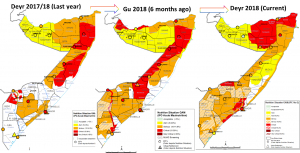
Water and sanitation
The main water sources of Kandala areas are harvested rainwater. Due to the failure of the Gu’ rains, all the barked in the region are empty. Respondents reported unusually high and rapidly increasing water prices, surpassing levels never witnessed during the two years long drought. It is anticipated that the demand of water in Jilal (March 2019 – August 2019) will increase further driving the prices of water to already unaffordable levels. It is estimated that one poor household will spend an extra US$200 for water in the coming two months while at during the same period they will experience an income deficit of US$150.
This is compelling many herders to sell more animals to buy water. Besides, many have been forced to enter into credit arrangement to secure food and water. The high demand, which is leading to high livestock sales, is detrimental to the growth of the herd sizes and will greatly affect the process of recovery from effects of previous droughts. The bottom line here is that all this will have negative impact on the overall food security in Bari region. To minimize the high risk of asset loss and human death occasioned by the prevailing water crisis, the team recommends an urgent large-scale water trucking and repair and maintain the broken boreholes. There are two permeant water sources in entire kandala district one spring water system in kandala town and one borehole in ceelgaal village which is not functioning at the time of the assessment.
The boreholes (traditional dug boreholes in some areas locate in naturally water saved points) in operation remain an important source of water for both people and livestock but are under strain because of overuse. Communities are finding it increasingly difficult to afford the diesel required to run the pumping operations as well as spare parts for the generators and pumps. Large concentrations of pastoralist communities around permanent water points are common, as water pans and berkeds have dried up. However, the concern is that public health standards are under growing strain as populations cluster around the few remaining water sources
Livestock and nomadic people are inseparable, as it’s a major source of their livelihood. However, water for livestock is a challenge for most pastoral households. On average, camels will need between 100 – 120 litres of water a day, cattle (80-100 litres), while the small ruminants (goats and sheep) will require 5- 10 litres of water, every 3-4 days. Due to the prolonged drought, most animals are unable to walk to distant water points, given their weak body conditions. The provision of water for livestock continues to increase household expenditures, further depleting their savings.
The reduced quantity and quality water have adversely affected the health status of the people, especially the vulnerable poor, women and children. The biggest health concern in the region at the present time is Acute Watery diarrhea (AWD), which can be attributed to scarcity of water and poor hygiene. Awareness of the quality and safety of water was also found to be limited.
The impact of the outbreak of AWD, particularly given the fluid movement of pastoral populations requires appropriate interventions on key issues such as scale up of access to safe water, sanitation and hygiene promotion
Nearly 100% of the rural and pastoralists households assessed reported that they do not treat drinking water. In at least 2 villages, communities used traditional herbs (Galool) in Berkeds to prevent diarrhea diseases.
Access to latrines is a critical concern. Open defecation has been observed in most of the sites visited due to lack of household latrines. The latrine to person ratio was 1:39, in the 70 villages assessed. During focus group discussions, female respondents voiced their fears over using open areas during the night.
Education
Access to basic education remains a huge challenge across the district and education figures are among the worst in the Puntland. The average Gross Enrolment Rate (GER) at primary school level in district stands at12%, with rural population enrolment, and girl learner enrolment (at 6%), oscillating even lower. More than 80% of school aged children are still out of school and children from pastoralist communities, urban poor, children with learning disabilities are particularly disadvantaged. The education sector is also characterized by a high dropout rate. According to school census for 2011/12, 22% of those girls and 17% of boys transiting to upper primary dropped out of schools. Children and youth from marginalized families and urban poor in general and girls in particular are the most affected. This is due to both the direct (school fees, learning materials and school uniforms) and indirect costs (children from poor families often have to work to support their families) of education. The situation is exacerbated by harmful traditional practices, recurrent drought and insecurity. Addition to children belong by the droughts effected population, current displaced people’s children and most vulnerable children are currently missed of education because of lack of school fee education.
During assessment, the TSS staff visited and witnessed some buildings which are named as school but some of them are not functional because of lack of schooling facilities, many informants interviewed about the schooling issues were reported that, so many school aged children are not attending in schools because of lack of teachers, some respondents indicated that the qualified teachers left from area and went to the main towns because of lacking proper salary. other respondents indicate that if found other facilities of teaching mechanisms still most of the out of school children will be attend in school because of parents don’t pay fee school fee due to vulnerability.
Health
Poor of health facilities and un- functional buildings
During humanitarian gaps assessment, the TSS’s assessment team found that the health facilities in the Kandala district areas are limited and few villages have health centers and MCH which are functional while others are facing inadequate facilities, lack of staff salaries and poor performance of medical reporting. During assessment were seen only two functioning hospitals, In Kandala town, the national hospital is functioning with the help of one international agency, Som-Building Company and TSS have provide solar system in order to start a Cole-chain for EPI materials. But the hospital has same problems with others. Second hospital is Balidhidin general hospital, the hospital was sponsored by DANIDA and implemented by TSS and the community, the hospital seems very concretive with good look but has problems of medical reporting, inadequate facilities and lack of qualified staff. Kandala district have an old Ambulance which cannot cover for all needs, this ambulance works no all villages because it sometimes lacks fuel or need extra repairing. Sometimes villages use other rented cars which calculates more US$ 500 for emergency (From there to Bosaso hospitals)
As per the field questionnaire data, 10% indicated that the settlement has a health facility where 60% stated there is no health facility, while 30% reported that skeletal building without medicines and health workers. Of the villages with health facilities, 24% were said to have MCH while 7% indicated that they had health posts.
Major disease: the common diseases in these areas are tuberculosis; malaria, typhoid, pneumonia, esophagus barium and dysentery infections and diabetes are also reported
On the other hand, due to limited time and or the absence of technical health professionals in the all teams, it was not possible to conduct an in-depth investigation of diseases outbreak in all locations visited. However, when asked whether there is noticeable increase of deaths due to disease, in the visited villages 80% of populations interviewed indicated that major deaths we face are maternity and morbidity death and also other complicated diseases cause by malnutrition they have added. This information can only be verified by trained health personnel in collaboration with partners operational in these settlements.
Life of fatal stories: During assessment, the staff reported that two pregnancy ladies were took from Turmasale and Af-dhariimeed for baby delivering problems have died in the mid of the way.One baby boy with abscess has taken from Turmasale area and the vehicle took 250 dollars for transportation only. Two pregnant women had transported to Bosaso due to getting baby delivering facilities, fortunately they had safely reached to Bosaso and safely delivered a baby but the cost of transportation was very high. This will make hard to provide efficient health services access to the community.
Nurtition
Similar to health cluster findings, much of the nutrition findings from the assessment field data will need further technical and in – depth investigation by the nutrition issues especially in areas where household interviews showed the high prevalence of acute malnutrition in women and children.
In addition, the assessment teams did not carry out any technical screening of malnutrition such as MUAC and instead only relied information from FGDs and Key Informant Interviews. The overall analysis of the data showed 98% evidence in household acute malnutrition among children and women, with 76% of them indicating difference from the usual acute malnutrition at this time of the year. Likewise, 62% of the all respondents in all locations stated that they have access to some form of Nutrition program. Most of the households indicating that they don’t have access to any nutrition programs were take place in other areas of Puntland because a hard to reach areas another security concerns. Again, the feedback from the household questionnaires will further need more technical investigation and follow up by the nutrition cluster.
According to the assessment, the teams observed and learned the following points:
Since the increased of IDP population from different parts of the district including people fleet from areas settled by the terrorists, those are live in desperate situation in the urban areas and associated former IDPs and had fleet again from terrorists, recently bankrupted former nomadic and settled in the rural areas with their relatives. Water shortage occurs in the areas after they witnessed a two your recurrent drought. Since the household income decreased in to lowers stage and each family lives in rural villages hosted at least another one house hold that had fleet one of the four hardness issues existed in the district. Addition to that Kandala district has not ever received a proper nutrition. Due to these mentioned problems, the severe malnourishment issues occur in the Kandaladistrict. Malnutrition has increased beyond the emergency threshold (above 15%) in Kandala due to food scarcity and declining milk production. The nutrition situation is expected to worsen, unless nutrition, food and WASH interventions are prioritized. The malnutrition data obtained from the few MCHs in the area suggests increased cases of malnutrition. In March, at least 65 cases of malnourished children were recorded in an MCH in Balidhidin village, the malnutrition cases are not only exclusive to children, but also included pregnant and lactating mothers. The increased rates of malnutrition among children can be attributed to food insecurity, but also due to sub-optimal child-feeding practices, low coverage of health services, and lack of clean water supply.
NFI and shelter
According to the findings of the assessment, there has not been that physical organized displacement. However, the reports from the various assessment teams showed that more than 2500 HH have been displaced by the renewed drought since late 2018 which only represents the data collected from the sample locations visited by the teams. In most of the locations visited, there is no presence of organized IDPs settlements mainly from the previous drought was visible with many of the newly displaced joining these villages living with their relatives in major villages and town. In each of the locations visited, teams recorded number of displaced households and where they moved to as well. In some cases, pastoral families divided among family members where men and old people migrated with livestock to areas with better pasture and water while leaving children and elderly behind. Most of these children and elderly who were left behind either joined their relatives in villages and towns or few of them joined spontaneous settlements near these villages or town.
Protection
All villages and areas assessed indicated that majority of the remote areas rely on elders and community leader’s security and or other community shareholders actors rather than other forms of law and order enforcements such as police or national armies. Hence, 80% of the households reported community and non – sate actors as main structure for law enforcement in the villages. Only 10% said there is no any structure of law enforcement in their village while 10% indicated police and community police as the main law enforcement structure in the Village.
The persons with disabilities have been reported for all assessed locations. Also, persons with chronic illness among other vulnerable persons listed in the forms were also reported in almost the assessed locations. According to data, 79% of the households indicated the presence of such people. Only 10% indicated no presence of such persons while 11% indicated the presence of women and girls in their communities. While GBV incidents were not capture as the forms did have such question, the key informant interviews indicated that many children are separated from their families, especially pastoral households, and they were left behind to live with relatives in major villages and towns.
Recommendations
Education Recommendations
- Provision of school facilities to the most of the areas visited in Kandala including building new schools, rehabilitation of the damaged classes, renovation of separated school latrines ( for girls, for boys and even the school staff will have a separate
- Strengthening school water and sanitations, most of the schools visited were underperformed of water and sanitation.
- Staff salary including teacher’s incentives, most of the villagers indicated that the school aged children are not attending in school due to lack of school fee. Provision of teachers salary will encourage him/her to the rural village.
- Provision of schooling materials to the most vulnerable children including uniforms, exercise books, text books and recreation materials.
- To building new location in schools, according to Jaceel stream, there are so many villages which has no school premises, we are strongly recommended to build new schools in the mid of the villages.
- To conduct extensive monitoring and evaluation, this will enhance the level of schooling program.
Health recommendations
- To rehabilitation the existed health centers in some areas have identified by the assessed teams like Xijiile health center.
- Any each health center will be in two programs OPD and MCH, the staff of this health center will have especial day of mobile health centers in the assigned areas of the catchment.
- Each health center will have two health professionals including qualified midwife and qualified nurse.
- Each health center will be suited for the medicine books including where there are no doctors, community health workers hand-book and other books developed by WHO and Medicines Sans Frontiers.
- To increase number of Ambulances in the areas like one in Balidhin Hospital which can able to visit in some Where in Jaceel main Stream which has so many scattered village with full of rural and pastoral population, other Ambulance will be in national hospital in Kandala town, other one will be in Unun main villages. Each Ambulance will have at least one health professional especially midwife and emergency kits.
- To provide salary of health staff in Kandala district.
- At least two qualified doctors will based in the areas, these doctors will often travel to areas, and one female will be included in these two doctors.
- Medical facilities will be provided to area, this will be periodically concern with implemented agency and sponsored agency. This will be include provision of medical supply to areas and receive medical report.
WASH recommendations
- Urgent Water tracking, Sanitation and Hygiene awareness: is needed by villages and households who are not able to pay water charges, so many displaced people are live with their relatives.
- Drilling strategic new boreholes in Bali dhidin, Tuurmasale and Dhaadaar villages to increase the resilience of the communities
- Extend water supply and water vouchers to most of the communities in most villages visited.
- Water trucking for livestock and human consumption in areas with extreme water shortages
- Distribution of aqua-tabs and water disinfection (chlorination)
- Provision of water bladders, family water containers / jerry cans
- Rehabilitation of the strategic water systems in ceelgaal and kanadala town.
- Awareness raising on Personal hygiene and sanitation
Recommendation of food security and livelihood
- Food Assistance is needed by villages, areas visited is recommending for food assistance, TSS is implementing food voucher project for only 1000 household, and the identified vulnerable people need food assistance are over 3500 households.
- CFW, FFW and Blanket Supplementary feeding to address mainly in rural communities and more cash interventions for IDPs especially those displaced as a result of drought.
- Vet drugs and Vaccination of livestock
Nutrition recommendations
- Urgent Nutrition programs like OTP programs are needed all across surveyed villages because most of the children and mothers they were surviving nutritional problems due to the prolonged droughts and also lack of nutritional awareness.
- Scaling up nutrition interventions in displaced affected communities and integration of nutrition projects both Outpatient Therapeutic (OTP) and Target supplementary feeding programs (TSFP) in drought areas is recommended to increase access and ensure effective management of acutely malnourished children and women in the affected communities.
- Promotion of infant and young children feeding practice is also suggested, this will contribute prevention of acute malnutrition for under 2 yrs children during the drought.
- Addressing underlying causes of malnutrition among women and children through food distribution and unconditional cash transfer as well as provision of clean drinking water is highly recommended.

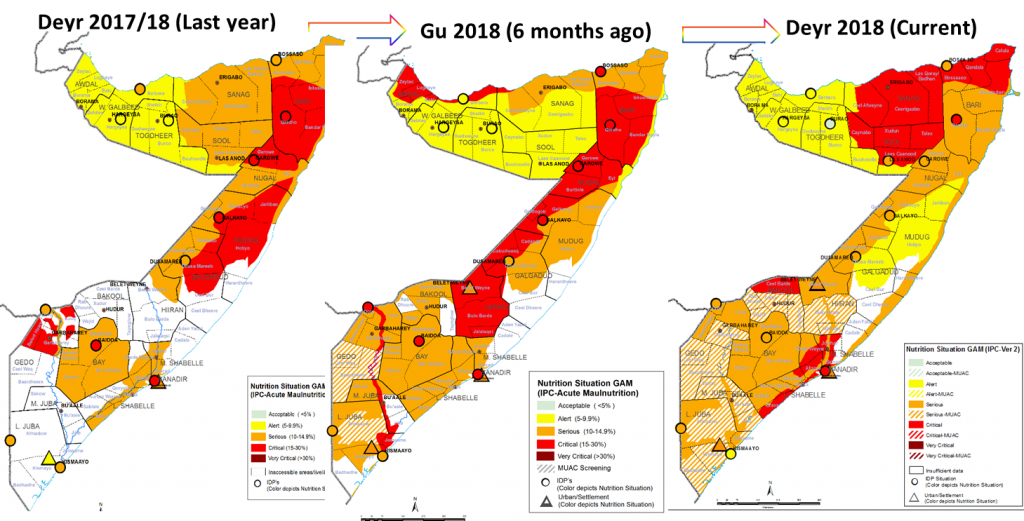
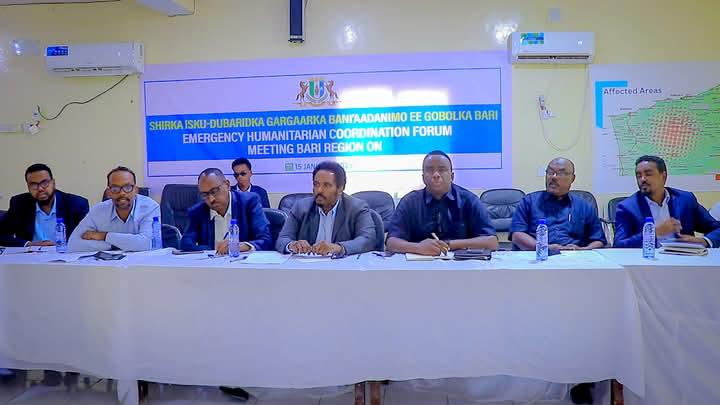
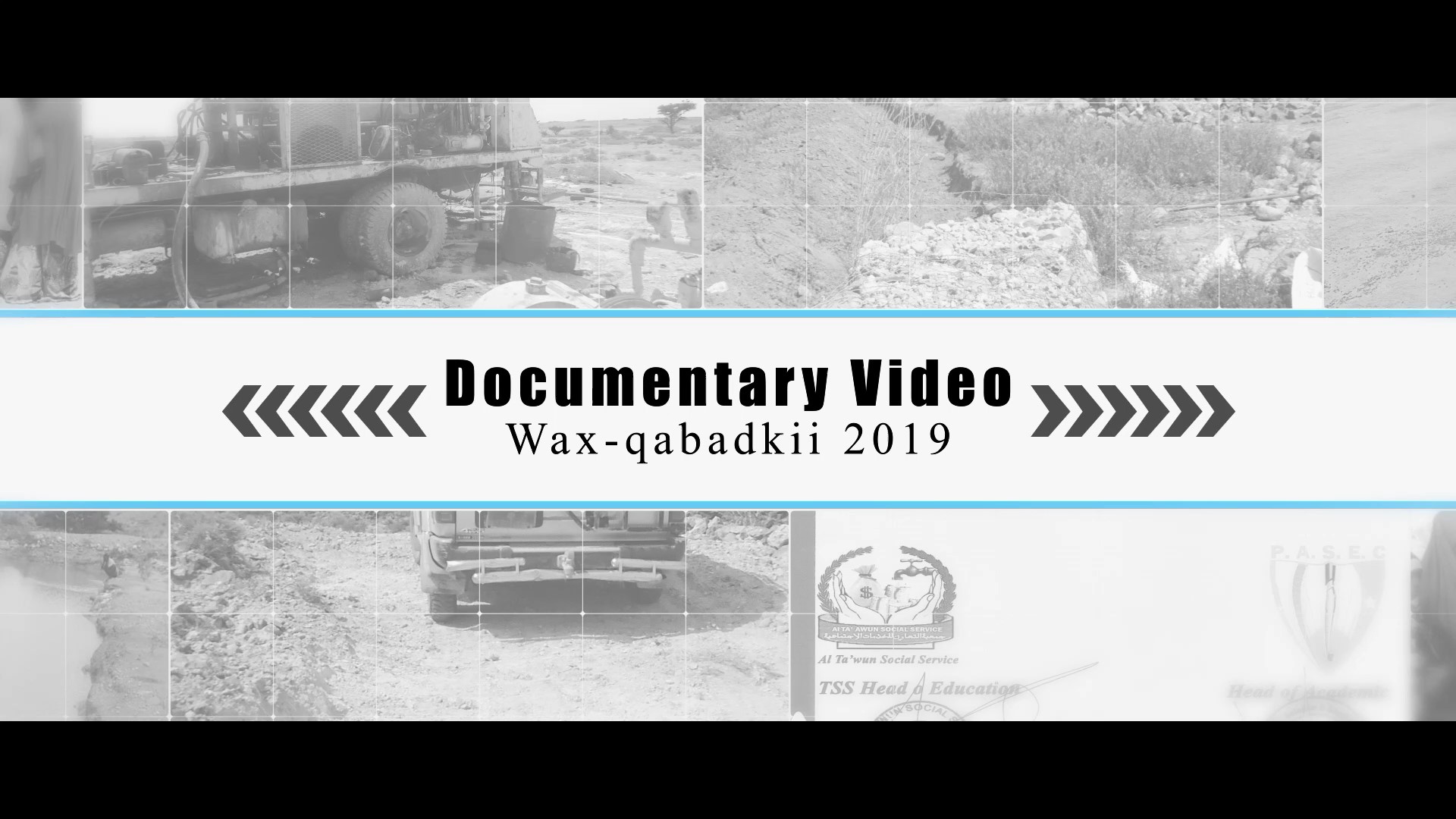
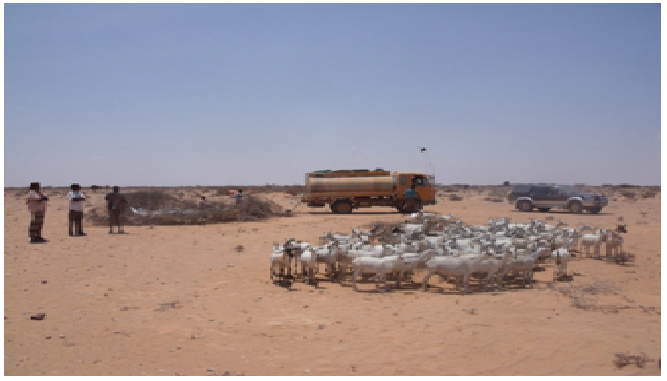


Recent Comments